06 May 2025
Dhaval Gajjar
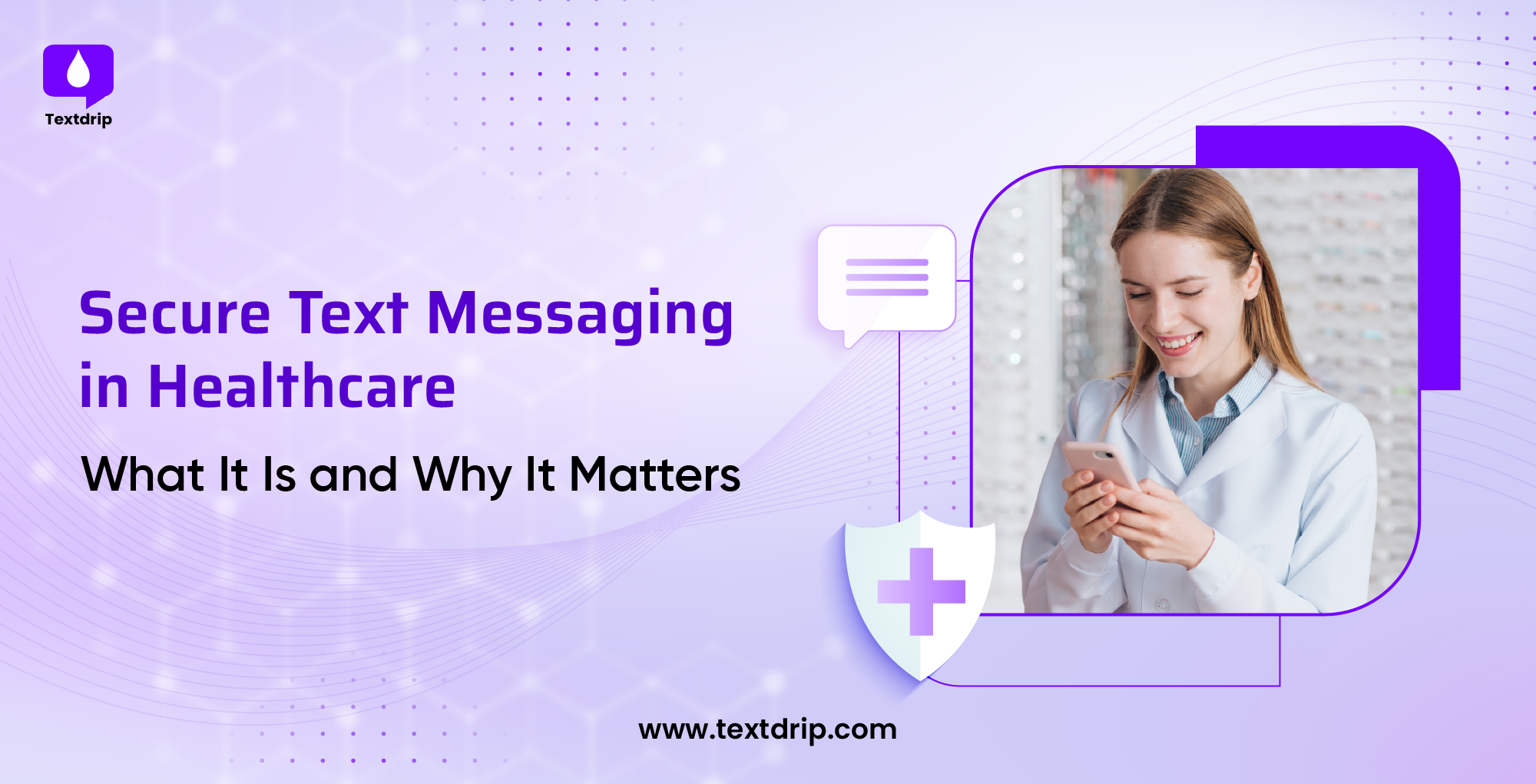
06 May 2025
Dhaval Gajjar
Text messaging in healthcare is an easy, quick, and personalized way for doctors, nurses, and other healthcare professionals to communicate with their patients and each other. As SMS is convenient, quick, and can be HIPAA-compliant, most healthcare professionals are turning to it. However, here, the question is, why is secure text messaging for healthcare needed in the first place? The reason is simple. When you send a message to patients regarding their appointment, pass their details to the healthcare team or refer them to specialists, you deal with sensitive data. These data are patients’ data, which reveals their identity in the healthcare space. This information is known as PHI – Protected Healthcare Information. HIPAA guards it and sets the norm for storing, sharing, and handling patient information. So, under the watchful eyes of HIPAA, you must practice secure text messaging for healthcare.
This blog explains what secure text messaging in healthcare means, why it matters, and why it is important to your practice.
While communicating with the patients, regular text messaging is not a secure way to share PHI–protected health information. The reason is that unauthorized individuals can easily access and interrupt regular SMS because they lack encryption.
Regular SMS are prone to data breaches because they’re stored on the telecommunication provider’s servers. Therefore, if you’re a healthcare professional wanting to communicate effectively with patients via texting, you must use a secure healthcare texting platform like Textdrip. These platforms protect patient privacy and adhere to HIPAA regulations.
In short, secure text messaging in healthcare offers various benefits. It protects patient privacy by ensuring that the patient’s private information does not fall into the wrong hands. Through secure messaging, healthcare professionals can respond instantly no matter where they’re, so it improves response times and, in many cases, helps save lives. Secure text messaging offers quick clarifications on allergies, patient preferences, and allergies. It helps prevent medical mistakes and improve patient safety.
It might happen that, in some cases, multiple providers are involved. In such a case, secure texting improves collaboration by helping them stay aligned and informed in real-time. Secure text messaging adheres to HIPAA standards, which helps avoid costly mistakes. Due to these reasons, secure text messaging matters in healthcare.
Let’s understand how standard text messaging differs from secure text messaging.
| Feature | Standard Text Messaging | Secure Text Messaging in Healthcare |
| Data Encryption | In standard text messaging, messages are sent in plain text. These messages can be easily intercepted during transmission or easily accessed if the device is compromised. | In secure text messaging, messages are encrypted during transit and at rest. Therefore, even if messages are intercepted, they will remain unreadable without the decryption keys. |
| HIPAA-Compliance | Standard text messages are not HIPAA-compliant. Therefore, sharing PHI through SMS can cause serious privacy violations and legal penalties. | Secure text messages are fully HIPAA-compliant. These message platforms are designed to protect PHI and follow compliance standards. |
| User Authentication | In standard text messaging, no login is required. Anyone who has access to the device can read messages. | Secure text messages require secure login credentials, biometric access, or multi-factor authentication to access messages. |
| Device Security | Messages are stored on the device with no control from the organization. So, if the phone is stolen or lost, data can be exposed. | In secure texting, messages are automatically deleted after some time. Besides, remote wipe options are available if a device is compromised. |
| Group Messaging | When you send group messages, it can reveal all numbers and information to unintended recipients. So, no access control. | In it, group messaging is controlled, so only authorized users are added. It is perfect for care teams, emergency conditions, and shift changes. |
| Message Control | Messages remain on devices unless they’re manually deleted. | Secure text messaging includes time-based expiration and auto-deletion features, which minimize data exposure. Admins can set rules for message retention. |
| Device Management | Organizations do not have any control over how devices are used. Therefore, users might use personal phones without security measures. | Various platforms offer mobile device management features that allow admins to enforce strict security policies on user devices. |
| EHR Integration | No integration. Texts are isolated and not linked to the electronic health record. | Various secure messaging platforms integrate directly with EHRs, which lets healthcare professionals send messages within the context of the patient. |
| Legal Risks | High because minor breaches from the unsecured messages can cause lawsuits or HIPAA fines. | It is significantly reduced. Platforms are built to minimize legal exposure via compliance and control. |
| Professional Communication | Informal and inconsistent because there is no formatting for clinical workflows. | It is designed with healthcare in mind. It includes templates, quick response, and features such as patient tagging. |
| Data Backup and Recovery | Standard messages may not be backed up securely. Lost data is hard to retrieve. | Secure platforms provide centralized backups, which help recover data if devices are lost or damaged. |
Text messaging is prone to risk; therefore, healthcare organizations must take proactive measures to prevent HIPAA violations. Here are some best practices to keep in mind when using secure text messaging in healthcare (secure SMS for healthcare).
Before you settle down on any messaging platform, ensure that HIPAA regulations bind the vendor. So, you must establish a signed BAA, which ensures that they follow the same security standards that your organization is required to follow. Without it, even if you choose the most encrypted system, it will not make you compliant.
Each message should remain in an unreadable format the moment it leaves your (sender’s) device and until it reaches the intended recipients. Even PHI can be intercepted without practising encryption, exposing sensitive data to unintended parties.
Every person does not require access to information in the healthcare setting. Therefore, give role-based access which ensures only authorized users can send, receive, or view protected health information via SMS.
HIPAA lets healthcare professionals send text messages to patients, but only if they have given explicit consent. Therefore, document and incorporate details regarding which type of message patients want to receive and ensure that the response from their side will be secure.
You must implement policies that require password protection, remote wipe capabilities, biometric authentication, and automatic lockout after inactivity. If the phone is lost or stolen, it should never mean exposed patient data.
Your messaging platform should verify each user’s login details before letting them access PHI. Employ MFA – multi-factor authentication, which needs additional verification steps beyond a simple password. MFA adds an additional security layer.
HIPAA compliance is more than keeping data secure. Ensure you record every message and who and when you accessed it. It ensures that any security incidents can be addressed and investigated. Also, regularly monitor these logs. It will help find unauthorized access attempts, identify suspicious activities before they escalate, and maintain compliance records for HIPAA audits. Use a HIPAA-compliant automated text messaging platform such as Textdrip, which provides you with the advantage of bringing all these features under a single platform.
Even if you use the best platform if your staff does not know how to use it, it is meaningless. Therefore, you must provide onboarding sessions, training, and clear guidelines for what can and cannot be shared.
You must respect when a patient chooses to unsubscribe from messaging. You should not send them messages again. Most SMS platforms do this for you automatically. However, ensure you follow it properly.
Here are a few use cases for secure text messaging in healthcare. First, we will go through some basic use cases and then we will check out those use cases that involve sensitive or semi-sensitive patient information.
The traditional method of verifying patients’ details requires phone calls, in-person verification, or paper forms. This task is quite time-consuming for patients and healthcare staff. It can cause delays if patients miss phone calls or are not able to return forms on time. So, you can use text messages to verify information of personal details, which require patients to verify and update their information directly using their smartphones quickly.
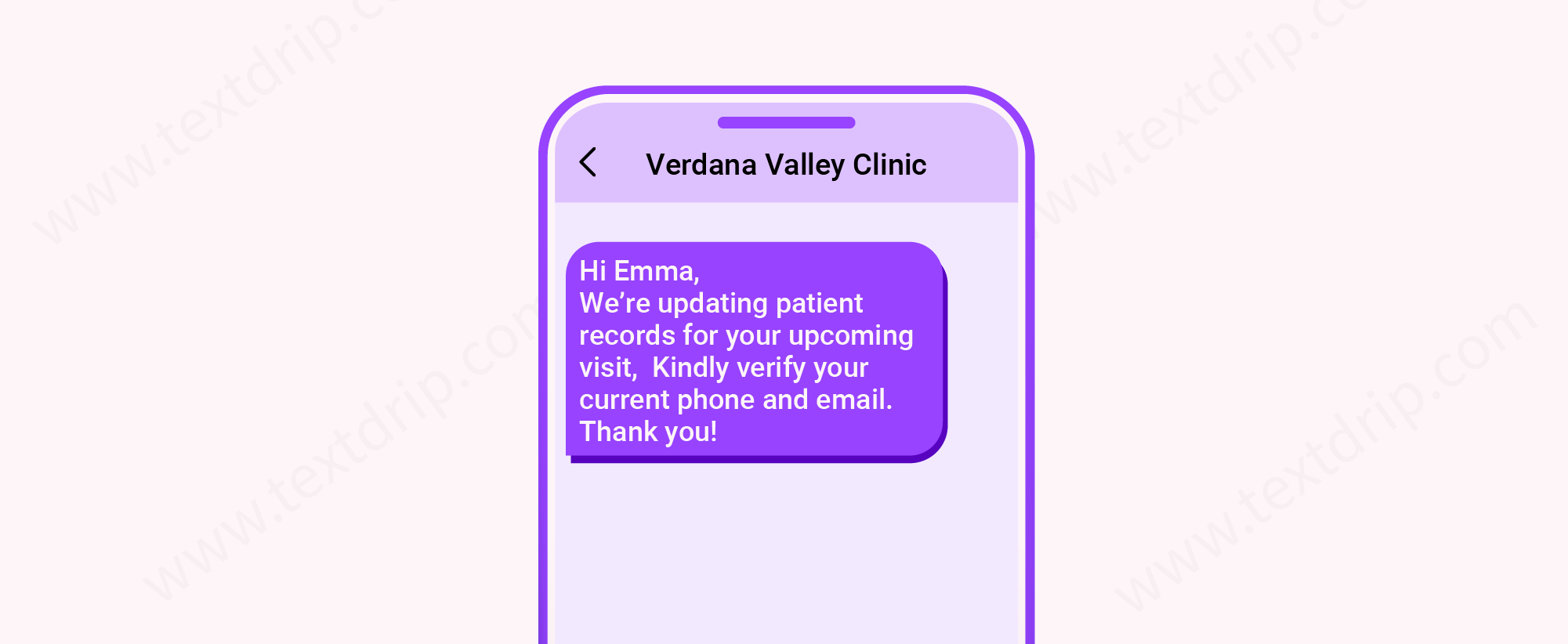
No-shows are a major challenge for healthcare service providers. SMS is a simple and powerful way to automatically send SMS appointment reminders or allow patients to confirm, cancel, or reschedule appointments.
Using an automated text messaging system like Textdrip lets you send reminders in bulk, which lets large clinics or hospitals keep track of their appointments with minimal effort.
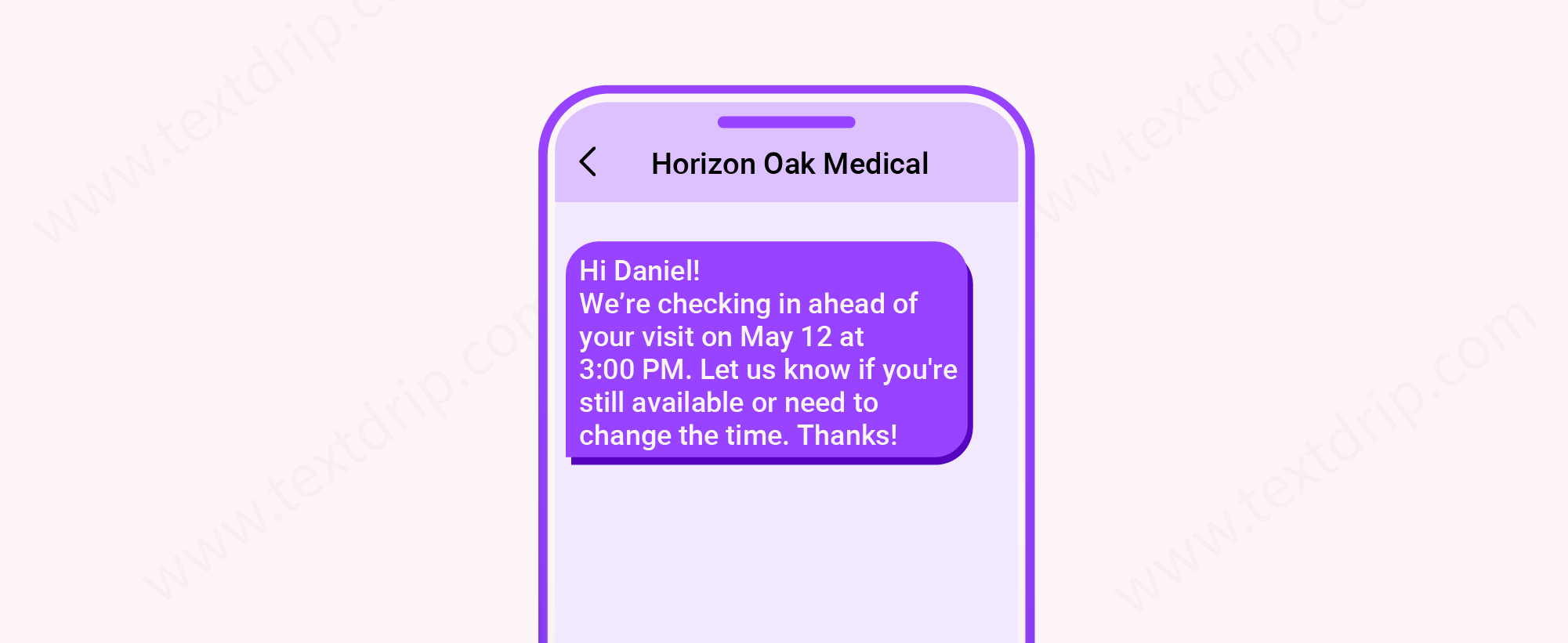
You can send follow-up messages to patients after the procedure or treatment to check on their recovery. These text messages can also remind patients regarding necessary follow-up appointments or actions. Many patients struggle with their busy schedules or limited transportation access. They would appreciate it if you offered the convenience of communicating through text messages instead of scheduling additional follow-ups.
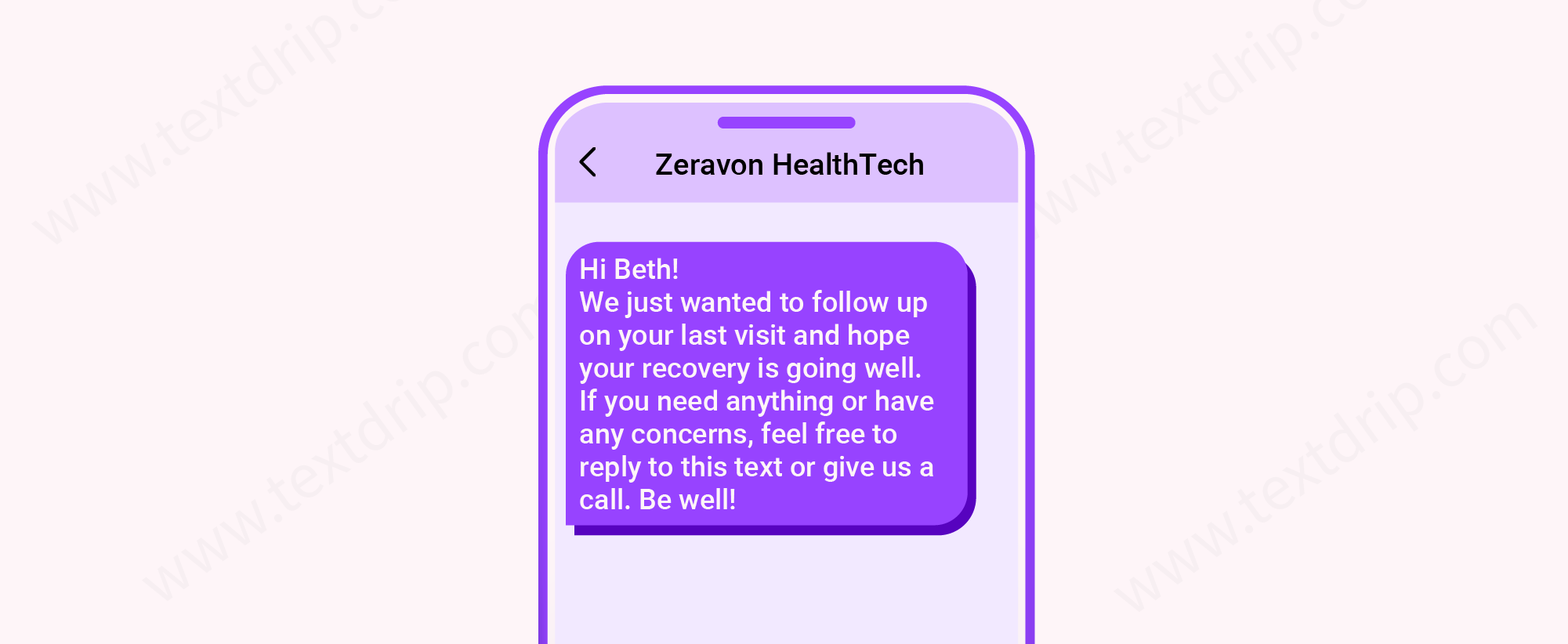
Late payments can strain any organization, especially in the medical industry. You can send billing alerts, payment confirmations, payment reminders, early payment incentives, etc., using text messages. It will ensure that your practice collects payments on time. You can include payment links directly in your message, simplifying the payment procedure. You can make it convenient for patients to settle their bills by incorporating a secure link redirects patients to an online payment portal.
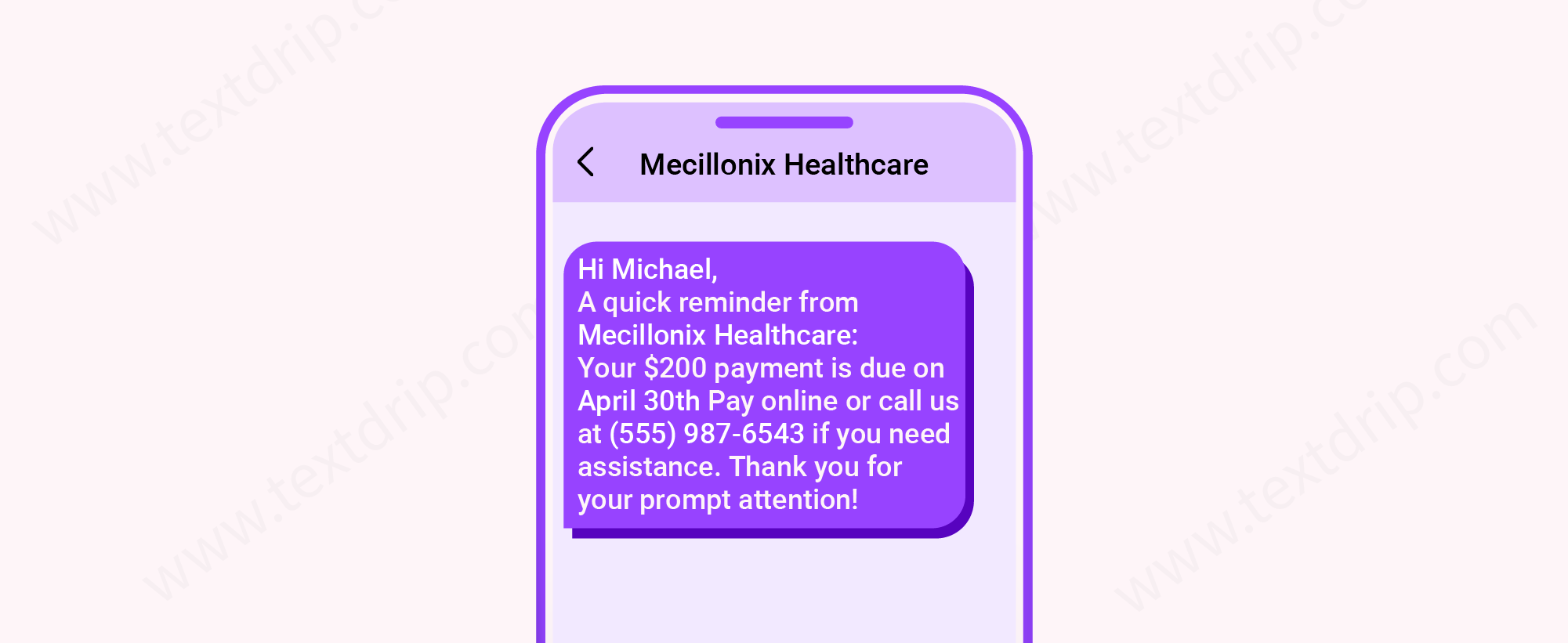
With text messaging, you can keep your staff informed and connected. You can text individuals, groups, or your entire workforce. It will help you schedule, fill last-minute shifts, remind staff of updates or meetings, or send emergency alerts.
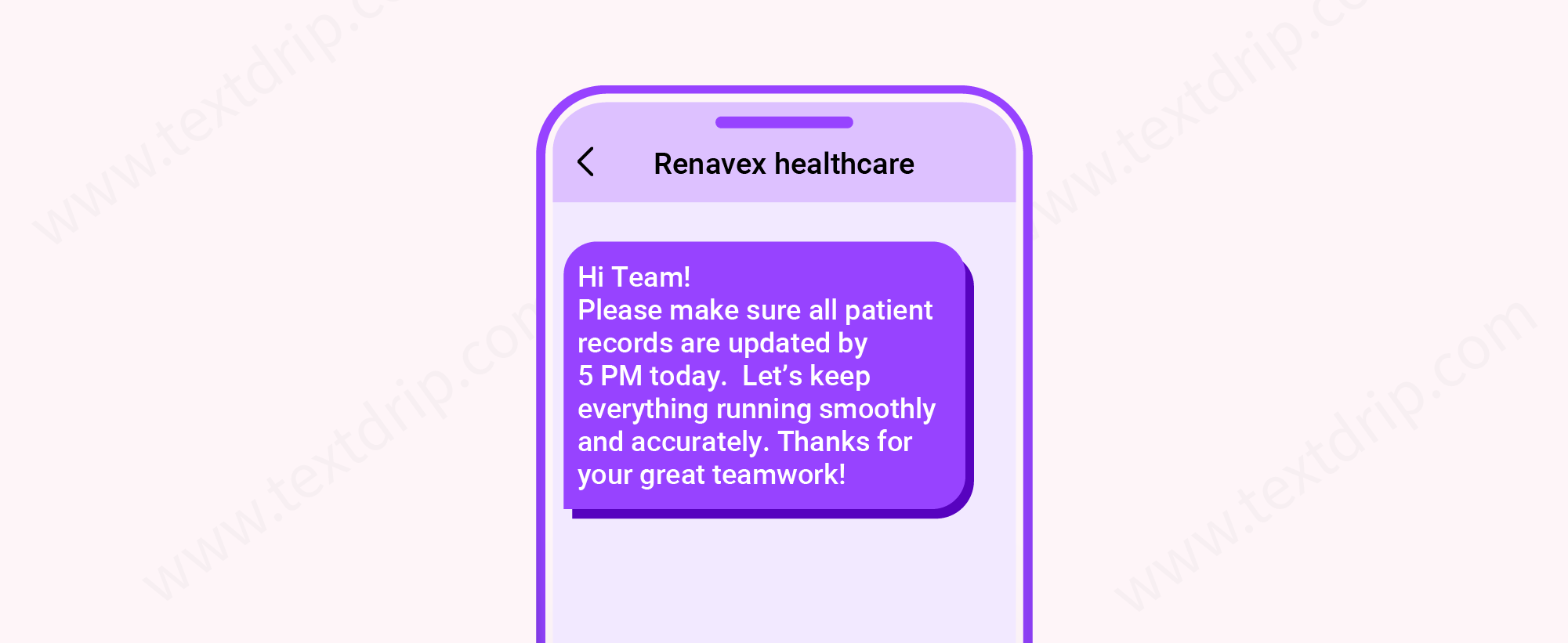
Text messaging is an effective tool which helps promote preventive care. Healthcare professionals can send educational reminders regarding vaccination, annual check-ups, or routine screenings, which are essential for early detection or prevention of diseases.
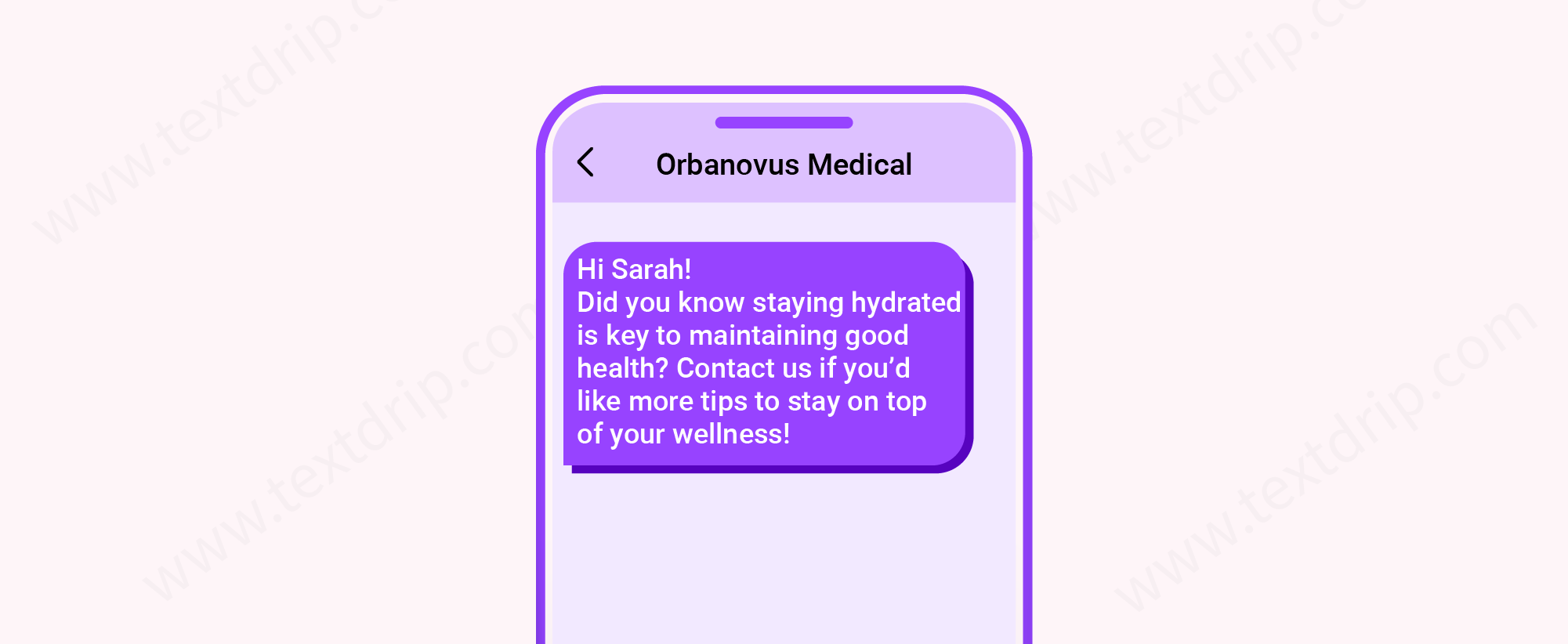
SMS is the quickest and most efficient way to gather feedback after patients visit a clinic or get treatment. You can send automated text messages to patients after their appointments. It will allow them to offer feedback while their experience is still fresh in their mind.
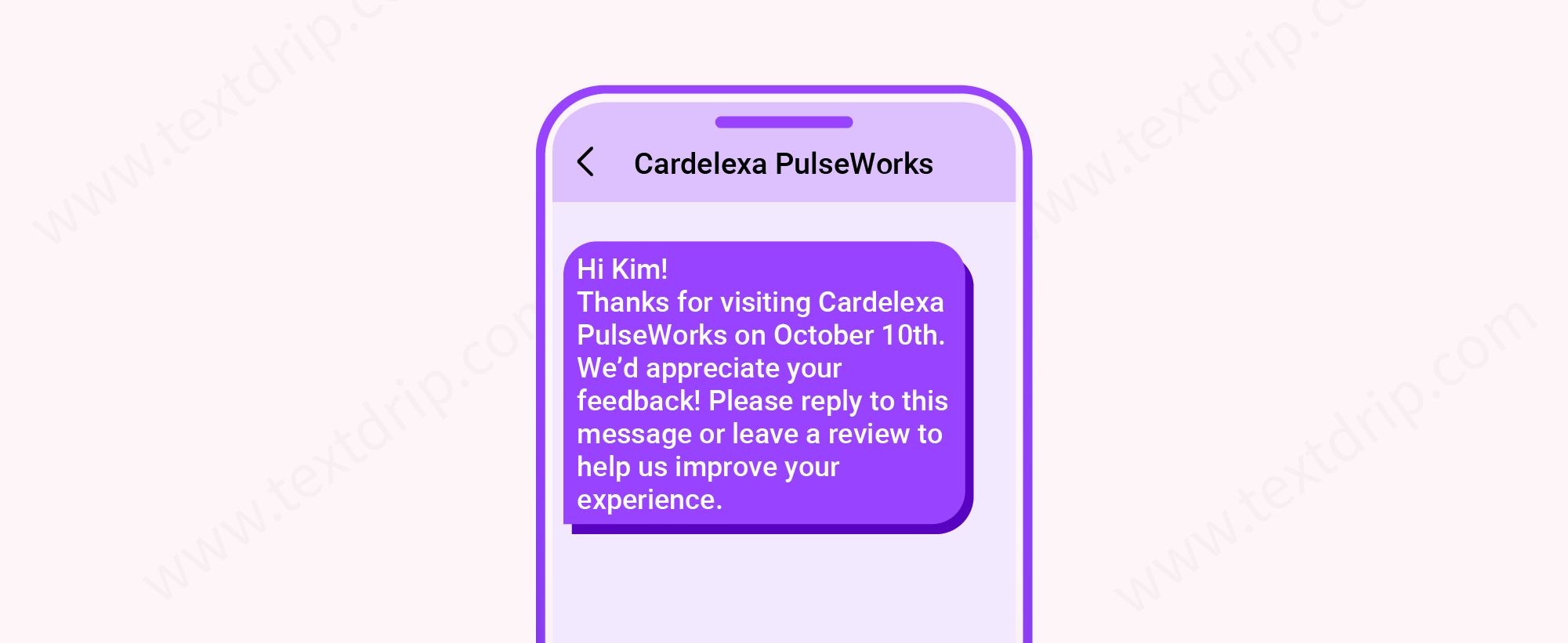
These days, healthcare has become more digital; therefore, you need to provide customer support to patients. For example, patients might need help understanding their invoices, logging into their accounts, or scheduling/rescheduling their appointments. You can use text messaging as a medium to address their concerns.
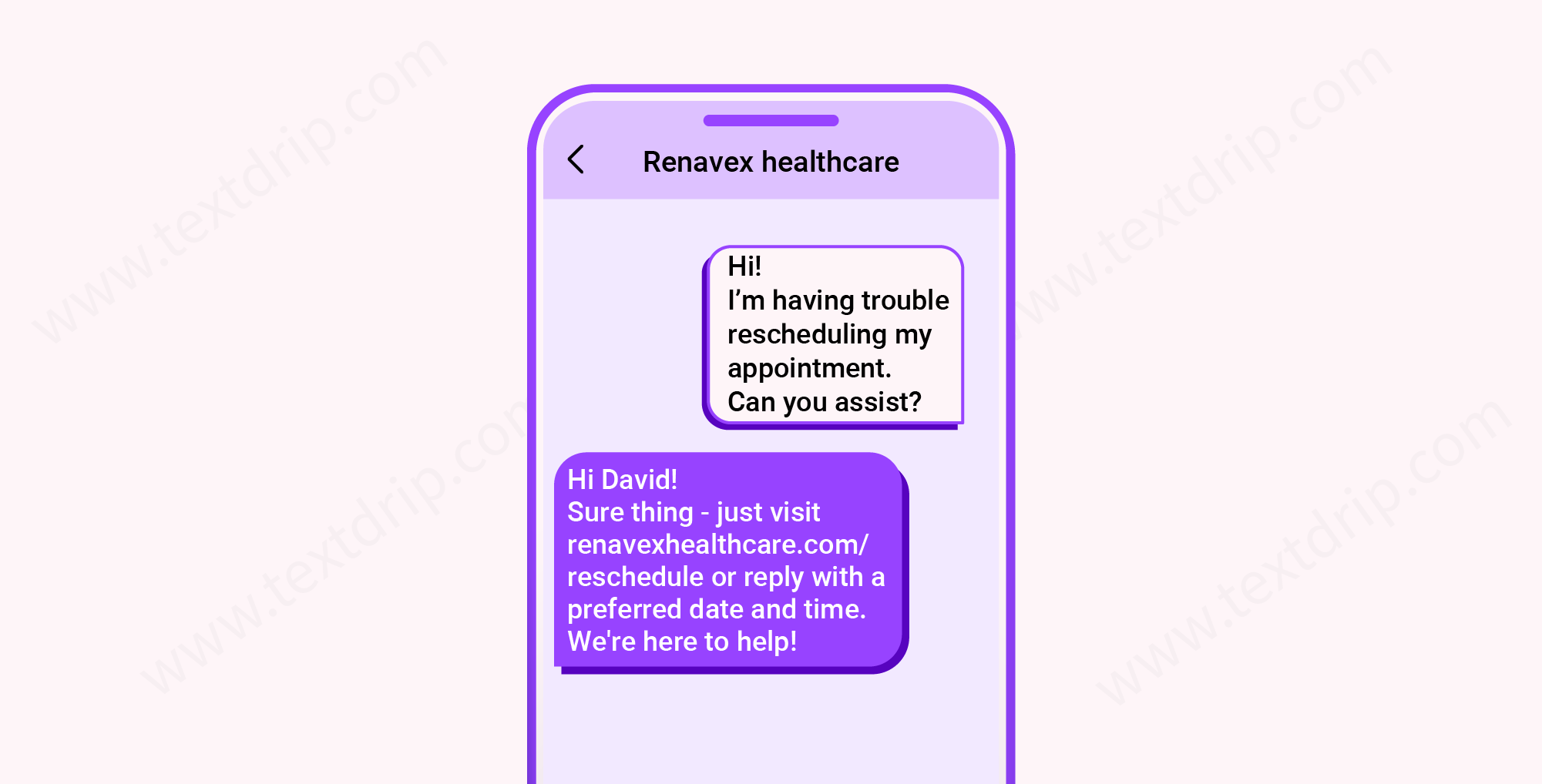
You can use text messaging to let patients check into their appointments. It will eliminate the requirements for the lengthy in-person registration procedures. Before the scheduled visit, patients can receive text messages, which speed up the check-in process.
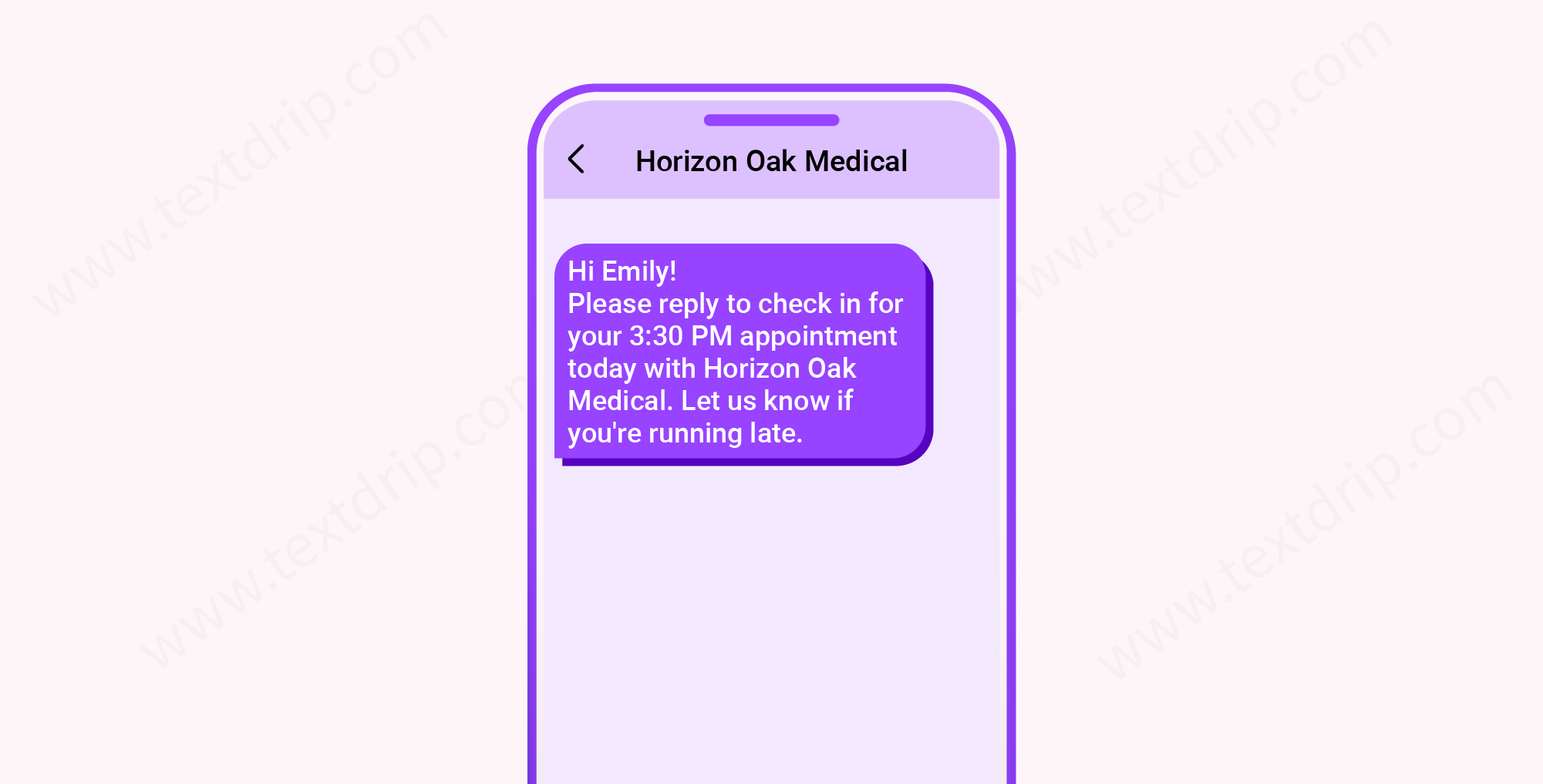
The following use cases involves sensitive or semi-sensitive patient information. You can use secure text messaging for it.
Prior to the appointment, if you want your patients to fill out specific documents, you can ask them to do it through SMS. For example, you can send them a link to the screening questionnaire before the appointment or a reminder regarding completing their check-in via their portal.
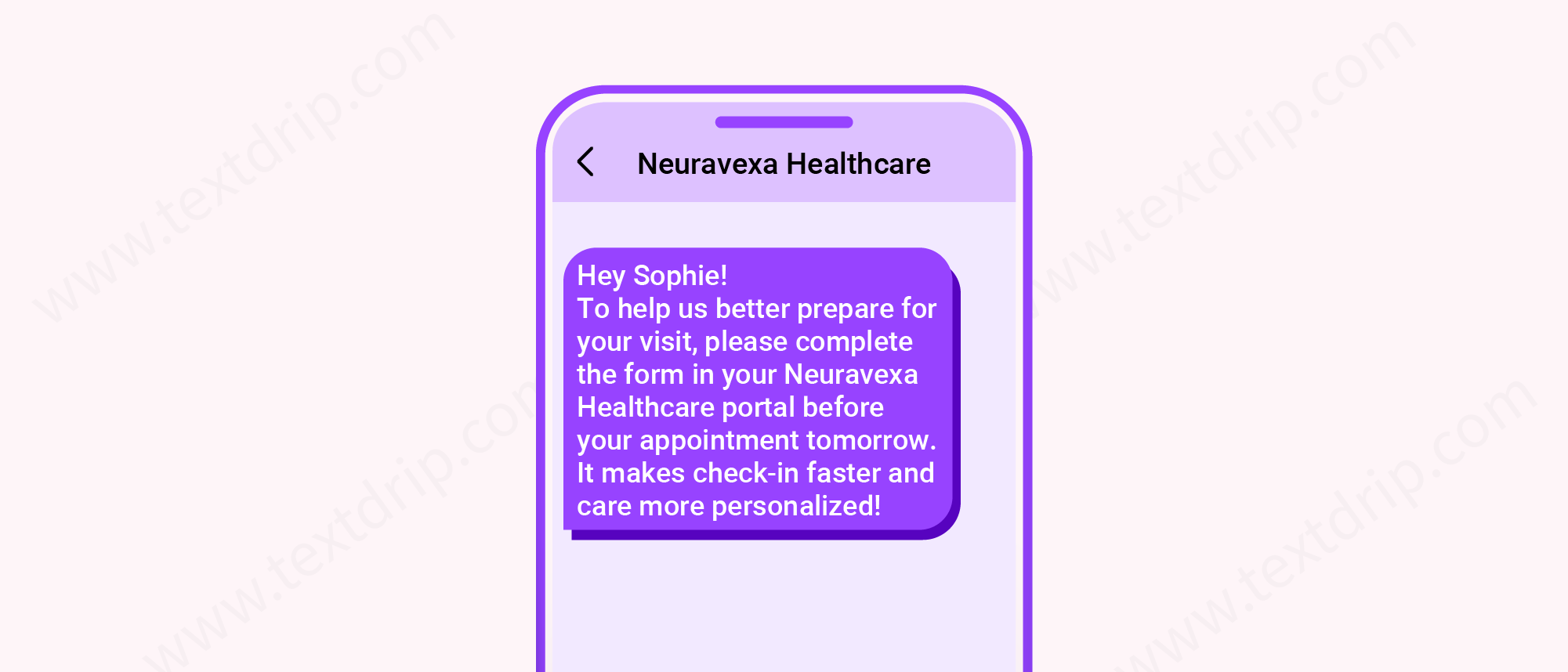
You can notify your patient that their test results are ready and encourage them to view securely or contact their healthcare provider.
Hello, [Patient Name]! Your lab results are now available.
Please log into your patient portal or call at [phone number] for details. – [Clinic Name]
You can alert patients that their prescription has been filled and ready for pickup. For that, you can send an SMS like this:
Hello [Patient Name], your prescription for [medicine name] is ready for pickup at [pharmacy name].
Collect it within 2 days.
If you have any questions, call us at [phone number].
You can inform patients via SMS that their treatment plan or medication regimen has changed after clinical evaluation.
Hi [Patient First Name], your care plan has been updated.
Log into your secure portal [portal link] or contact your provider at [phone number] for the latest instructions.
You can confirm that a refferal to the specialist like cardiologist, oncologist has been processed.
Hello [Patient Name]! A referral has been sent to [specialist type].
Plese check your patient portal for appointment details or call at [phone number].
You can notify patients managing conditions such as diabetes or heart diseas of critical changes in data (BP, glucose level changes)
Hi [First Name]! Your latest remote monitoring results have been reviewed.
Please log into your portal [portal link] to view feedback from your care team.
HIPAA compliance seems like navigating a maze. However, regarding text messaging in healthcare, you must remember the three important rules.
Security Rule – As per this rule, all the covered entities must implement technical securities for ePHI, such as encryption, audit logs, and access control.
Privacy Rule – This rule checks how and when patient information can be shared. For example, a patient name + diagnosis combination counts as PHI.
Breach Notification Rule – If PHI is compromised, the healthcare provider must inform individuals and the U.S. Department of Health and Human Services within 60 days.
Therefore, you must choose a secure messaging platform that encrypts all messages, prioritizes user authentication, respects opt-outs, and prevents message storage on unsecured personal devices. Go for the platform that offers audit trails and remote wipes whenever the device is lost or stolen.
Here are a few core features you should look for while choosing a secure messaging platform.
| Features | Usage |
| End-to-End Encryption | It protects data from when it is sent to when it is received. |
| HIPAA Compliance | The messaging platform must be HIPAA-compliant. |
| Access Control | Choose the platform that offers role-based access control. It ensures only the right people can view specific information. |
| Two-Factor Authentication | It adds an extra layer of protection if passwords are compromised. |
| EHR Integration | It ensures that messages, clinical data, and updates are synchronized in real time. This integration bridges the gap between messaging and patient records, reducing redundancy. |
| User-Friendly Interface | Go for the platform that has an easy-to-use interface. If the interface is complicated, no one will use it. |
| Remote Wipe Capabilities | If your device is stolen or lost, your messaging platform should be able to wipe all data remotely. |
| Audit Trails | Select the messaging platform that offers in-depth logs, as it helps with compliance and accountability. |
| Message Lifespan Controls | This feature automatically deletes messages after a set time to reduce data exposure. |
| TCPA Compliance | Besides HIPAA compliance, your messaging platform should comply with TCPA as it regulates how healthcare providers can send automated text messages. |
| Mass Texting and Automated Messaging | Choose the texting platform that lets you securely send mass texting and automated messaging for appointment reminders, follow-ups, prescription refill notifications, etc. |
Secure messaging is emerging in the virtual healthcare world. It lets healthcare professionals communicate with patients openly to provide accurate diagnoses while protecting privacy. Secure text messaging for healthcare is HIPAA-compliant communication that regulates who can access text conversations and how they’re stored.
Textdrip is a secure text messaging platform that provides end-to-end encrypted messaging, ensuring that only the sender and recipient can view the conversation. So, book a demo or start using Textdrip to send secure messages and protect patient privacy.
Yes, regular texting can expose patient data to breaches, violating HIPAA and putting organizations at legal risks
Secure apps often include auto-lock, PIN protection, and remote wipe capabilities to safeguard data on lost or stolen devices.
Most platforms allow secure two-way communication, so patients can safely ask questions or confirm information.
Yes, patients must always have the option to opt out or revoke consent to receive messages.